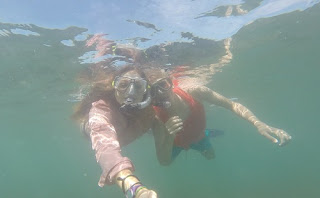When
I was a little girl, I would get so excited every time we went to the beach. I
would grab my snorkel, my little fishing net, and spend hours in the ocean
trying to catch and identify different sea creatures. As enthralled as I was at
the time, my snorkeling “adventures” were not the most interesting in
retrospect. I did not actually swim while snorkeling because I feared that I
would drown and therefore stayed within ten feet of the shore. The water was
also generally murky from the sand being upturned by the waves, and most of the
fauna was white. Any color that appeared came from the occasional piece of seaweed
that ended up in my net or from the small colorful coquina clams. Otherwise,
the fish, crabs, and shells were all white or silver. However, I thought that
this was the coolest experience ever.
My
perspective on snorkeling didn’t change during the week my OTS group spent in
Panama, but I realized how rich ocean ecosystems could be. Bocas del Toro was
absolutely surreal, and I took every chance I received to go snorkeling.
The first day was incredibly nerve wracking
because of the swimming test that we were required to take. I have never been a
confident swimmer, and I was afraid that I was going to have to forego this
portion of the program. Fortunately for me, my combination of doggy-paddle and
breaststroke was just enough to allow me to pass the test. Still riddled with
uneasiness, I started snorkeling in an area where I could still walk if I felt
the need to catch my breathe. I was absolutely baffled by how easy it was for
me to float on my stomach. With newfound confidence, I gladly joined my
snorkel-buddy out in the deeper waters. Over the course of the next couple
days, I even started diving down beneath the surface to get closer looks at the
flora.
During
our time here, we studied two distinct ecosystems: coral reefs and mangroves.
We looked at coral reefs in shallow waters (no greater than 2 meters), deeper
waters (upwards of 8 meters), and red mangroves. The mangroves were by far my favorite. The
first time I dove beneath the water, I felt like a little kid in a toy store. It
was a completely new world, and I couldn’t believe my eyes. I had found a
little secluded region where I was surrounded by various shades of reds,
oranges, blues and purples corals. Barracudas swam beneath me, huge schools of
fish encircled me, and tree branches from the red mangrove tapped on my back. A
few other students were even fortunate enough to find a seahorse. I scoured the
mangroves to find another but to no avail. From the surface of the water, I
would have never guessed how many species call the red mangrove their home. This
ecosystem serves as a nursery habitat for many animal species and are essential
for both ecologically critical fishes and commercial fishes.
If anything, these past few days have
bolstered the idea that we, as humans, need to protect the reefs and the
mangroves. Countless species rely on these unique ecosystems and, without our
help, could face extinction. Thanks to sea temperature warming, water
pollution, littering, and various other events our coral reefs are in sincere
danger. Every aluminum can I saw sitting on the bottom of the ocean or
entangled in the mangrove roots made my heart hurt a little more. It would be a
tragedy if future generations were unable to experience the beauty of the ocean
due to anthropogenic events.
- Kiersten Bell
Duke University



No comments:
Post a Comment